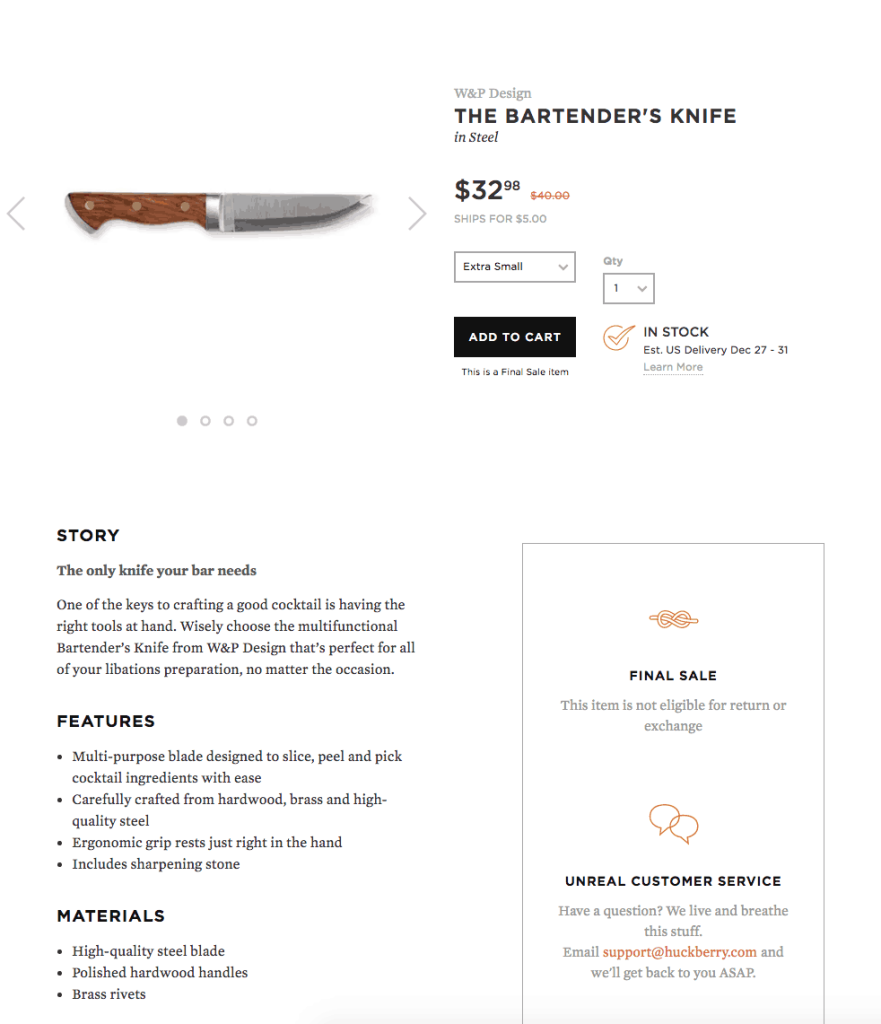Product descriptions are more than just a way to let your prospective customers know what they need to know about the things you sell.
They’re golden opportunities to convince someone that your product is truly the solution they’ve been looking for.
They’re also great opportunities to boost your website’s SEO, raise your SERP rankings, and improve the overall user experience your site brings to the table.
Here’s what you need to know to craft stunning SEO product descriptions that hit all the right notes.
- What are SEO Product Descriptions?
- Why are Product Descriptions Important for SEO?
- Do Product Descriptions Affect SEO?
- How Do I Add SEO to My Product Description?
- How Long Should SEO Product Descriptions Be?
- How Do You Structure a Product Description?
- 9 Tips for Writing the Best SEO Product Descriptions
- Wrap Up
What are SEO Product Descriptions?
SEO product descriptions are product descriptions written with best SEO practices in mind.
SEO (search engine optimization) is the practice of modifying and improving a website, webpage, or individual piece of web content to maximize its potential rank on relevant SERPs (search engine results pages).
There are many factors that contribute to good SEO, but most boil down to offering a better, more relevant overall user experience. Websites are better organized, content is written with easy readability in mind, and so forth.
When it comes to descriptions, there is no specific length they need to be in order to be effective.
If you don’t want Google to truncate yours, you can limit yours to 160 characters — the same as you’d do with meta descriptions.
However, some brands that sell more complex products or services may choose to expand descriptions to a couple of hundred words.
Why are Product Descriptions Important for SEO?
Online shopping is more than just a nice convenience these days.
It’s a crucial part of the modern consumer experience with many people relying on it as a way to shop for the things they want and need.
This is especially the case with millennials, as around 53 percent of them do most of their shopping online.
That means great SEO product descriptions are a must for any digital-age business hoping to boost sales, win customers, and succeed.
Here’s a closer look at why they’re important.
Better SERP Rankings
Most marketers and SEO pros focus the bulk of their SEO efforts on landing pages, but it’s crucial to fully optimize your product pages, as well. SEO product descriptions raise your chances of achieving an impressive search rank even higher.
Improved User Experience
Search engines like Google have come a long way since the early days of the internet and online shopping.
Choosing the right keywords isn’t enough anymore if you’re serious about improving your SERP ranking.
Your pages need to deliver a quality user experience on every level, and high-quality, fully optimized product pages help make that happen.
Higher Conversion Rates
The better optimized your product descriptions, the more likely it is that a search query will serve them up to the right consumers at precisely the right time — the moment they’re genuinely ready to convert.
This means higher-quality leads, better conversion rates, and soaring profits.
Do Product Descriptions Affect SEO?
It might be tempting to think of a simple, perfunctory product description as not carrying the same SEO weight that a long-form blog post or standalone web page might, but you shouldn’t.
Product descriptions are still web content, so it’s essential to approach them with today’s best SEO practices in mind. Here are some individual points to consider when brainstorming SEO product descriptions for your website.
Writing for search engines means writing for people
Since most consumers are really only going to skim product descriptions (when they read them at all), many digital marketers tend to write them with Google in mind, as opposed to their customers. But keep in mind that Google is in the business of delivering search results that meet the needs of real, live people looking for answers.
That means the best way to create SEO product descriptions that drive results from search engines is to write for people first. Tell consumers what they need to know about your product, and Google will happily send them your way.
Features and benefits are not the same things
Ineffective SEO product descriptions tend to over-focus on features and barely even touch on benefits (if it mentions them at all). However, many digital marketers don’t see the difference between the two.
Features are informational snippets like measurements and possibly also vague manufacturer’s copy that promises generic positives like excellent quality or fast shipping. On the other hand, benefits cover the unique advantages and perks customers will enjoy if they purchase this specific product.
Search engines like Google want to see you talking about benefits, not simply rehashing the same tired manufacturer’s descriptions posted on a million other websites.
Duplicate content is still a huge no-no
By now, most digital marketers and SEO content creators know that duplicate content will do nothing but hurt even the best, most thorough SEO efforts. This is just as much the case regarding your product descriptions as anything else.
So resist the temptation to simply copy and paste all or part of your descriptions across multiple product pages. Your customers may not notice or care, but it can cause significant issues for search bots when they arrive to index your website.
So, yes. Product descriptions do affect your SEO efforts – sometimes drastically – so it’s important to treat them with the same care you do your other content.
How Do I Add SEO to My Product Description?
Whether you’ll be writing your own product descriptions, handing the task off to a staff member, or outsourcing the job to a freelance copywriter, it’s important to understand what makes a good SEO product description. Here are some tips for better optimizing yours.
Give some thought to the structure
A product description isn’t the place to write your audience a novel about how amazing your product is. Consumers don’t read product descriptions so much as they scan them to find the exact information they’re looking for.
That said, the more skimmable you can make your SEO product descriptions, the better. Use short, concise sentences. Break up the text with elements like headings, line breaks, bullet lists, and (where appropriate) pictures.
Use smart keywords wisely
Choose keywords and search phrases that carry a high likelihood of helping your product pages rank. Naturally, no one is going to stop you from using highly competitive keywords, but you’ll get better results with examples that are frequently searched without being prohibitively competitive.
Never stuff your descriptions with keywords. Instead, sprinkle them throughout your text in contexts that feel natural and comfortable. And don’t forget to add them to titles, URLs, and metadata, as well as interlink relevant pages together when it makes sense.
Make your words count
Remember, people don’t consume SEO product descriptions the same way they might a personal essay from a favorite creative writer or a helpful blog post that answers a burning question they’ve had for a while. They’ll scan the content for what they need to know, and then maybe they’ll read that part.
SEO product descriptions aren’t the place to get wordy or overly prolific, as you’ll risk losing your reader. Stick to meaningful, authoritative writing that gets straight to the point and serves its purpose.
How Long Should SEO Product Descriptions Be?
Content length is a significant factor to consider when optimizing for Google and the rest of the search engines. Again, it’s important not to assume that rule doesn’t apply to product descriptions because it absolutely does.
However, there is no hard rule out there as to what length a product description should be to get great results and drive sales. What works for one example might not be the right fit for another. So how do you know how long to make your SEO product descriptions?
Consider the needs of the audience you’re targeting, and let that be your guide. How aware is the average consumer going to be regarding the benefits of your product? That’s going to dictate the amount of convincing they’ll need to pull the trigger on a purchase which will, in turn, tell you how long to make the content.
High Awareness Buyers
Some products are the type of thing nearly every person uses or has shopped for before. Examples include household essentials like toilet paper and toothpaste or commonly worn clothing items like socks or t-shirts.
People already know these products and are aware of the product benefits one option might have over another. They don’t need the full rundown of what the product is designed to do, so brief and to the point is best.
Low Awareness Buyers
These buyers are in the market for a product that may be more complex, less common, or completely new to many members of the target audience. Some consumers may be completely unaware of the fact that they need it at all. Examples might include software as a service (SaaS) products or advanced skincare items.
These buyers do need to know more about the product before they can be convinced to buy it. Keep things as brief as you can, but be as descriptive as you need to be to bring the customer up to speed on what the product does and why they need it.
In other words, product description length should always fit the customer’s needs. The less they need to hear about your product to be convinced to buy it, the shorter your description should be.
For comparison’s sake, consider how length works when creating standard content for a blog or a standalone web page. The more complicated the subject, the longer the content should be according to best SEO practices.
How Do You Structure a Product Description?
So what does the anatomy of an ideal product description look like? Again, that will depend on the product, the average level of consumer awareness, and where that consumer is as far as their buyer’s journey goes. But here are some tips to keep in mind for the best results.
Titles and Headings
As with standard web content, elements like titles and headings matter when it comes to SEO product descriptions. That means their structure matters, too.
- Titles should be descriptive but concise and contain your target keyword once.
- Never settle for a randomly generated URL that’s nothing but a jumble of random characters. Optimize it by using actual words (including your keyword) instead. Separate words with hyphens or underscores.
- For mid-length or longer descriptions, use headings to organize and break up your content. Use keywords when it makes sense.
You should also try to use your target keyword in title tags, meta descriptions, and alt image tags to ensure all your bases are covered.
Body Copy
This is the meat of your description – the part that will resonate (or not) with your actual consumer and help them decide whether to make a purchase. Again, let the associated level of buyer awareness dictate the length. Also:
- Make your words count by focusing on benefits, not features.
- Avoid language that’s overly salesman-like or promotional.
- Don’t use filler language or unnecessary words. Stay concise.
- Use short sentences – no longer than twenty words.
Make content easy to skim by organizing key selling points or must-know information into bulleted lists. And break up longer chunks of content with pictures, line breaks, graphics, and similar options.
Call to Action
People need (and prefer) to be told exactly what’s expected of them after they finish reading a piece of content, even if it’s just a product description. So close with a quick recap followed by a clear call to action.
Position your “add to cart” or “buy now” buttons where they’re easily seen and as close to the end of the description as possible.
9 Tips for Writing the Best SEO Product Descriptions
Ready to learn the ins and outs of creating fantastic SEO product descriptions that win customers and close sales? Here are some key tips to keep in mind as you write yours.
1. Know your target audience
Remember, effective SEO product descriptions are about more than just inserting the right keywords into your copy.
They’re about appealing to the audience you want to reach on a human level. But before you can write for members of your target audience, you need to know exactly who they are.
Start by taking a deep dive into your current customer base.
What demographics do they belong to, and what does their behavior as buyers tell you about them?
Then supplement your findings with additional research on who your competitors are targeting, consumer surveys, and similar means.
2. Understand best SEO practices
The basics of writing great SEO content definitely apply to product descriptions, as well, so it’s important to know them well.
Here are some pointers for using them to create product pages that sing:
- Make sure your descriptions are clear, helpful, and concise. Get to the point.
- Avoid using duplicate content, even if it’s your own, as it’s an SEO no-no.
- Don’t overstuff your product pages with keywords. That confuses both the search engines and your customers.
- Make sure your product pages are adaptive, fast, and mobile-friendly.
3. Write with your ideal customer in mind
The key to writing any type of web content that really resonates with readers — product descriptions included — is to write as if you’re speaking directly to someone specific.
When you try to address everyone at once, your writing can come across as vague and uninteresting.
Instead, write your SEO product descriptions with your ideal customer in mind. (Buyer personas can be very helpful in this regard.)
Write in the second person (using the word “you”), and use conversational language to help your audience connect with your words.
4. Choose keywords wisely
Keywords may not be all that’s important when writing effective SEO product descriptions, but they’re still absolutely essential if you’re serious about ranking well.
Smart keyword choices help Google better understand your pages and serve them up to the right users.
Start with a round of thorough keyword research. (The right keyword research tools can be valueble.)
Make your choices based on factors like:
- How many search engine users search that word or phrase (search volume).
- How easy or hard it will be to rank for that keyword.
- How many related terms would make great fits for your content (as with longtail keywords).
Long-tail keywords make especially smart SEO choices. The longer the search phrase, the more specific the user intent and the more likely your content is to be a good fit.
5. Understand how to place keywords
Once you’ve chosen your keywords, you’re halfway there, but you also need to know how to place them for optimal results.
Again, be careful not to overstuff your descriptions with keywords, as it’s easy to overdo it when working with short content.
Instead, focus on using keywords where they’ll help you the most. For example, try using yours once each in places like the following:
- Page URL
- Alt image tag
- Product description title
Then round things out nicely by using the keyword once or twice more within the body copy.
6. Write benefit-focused copy
A lack of enthusiasm is rarely a problem for companies and marketers when writing about their own products.
However, many tend to be enthusiastic about the wrong things. Think lists of tech specs, obscure product features, and other similar details.
While it’s definitely important to make sure specs and factual information about products are available to consumers, the key to grabbing your audience’s attention is a benefit-focused copy.
How will this product improve their lives, address their pain points, or make things easier for them?
That said, yes, you need to let the customer know what features a product brings to the table. But you need to do so by explaining the benefits of those features.
Check out this example from Huckberry:

7. Steer clear of filler copy
When copywriters are stumped as to what to say next in a product description, they run the risk of falling back on filler copy.
Think phrases like “great quality” or “affordable price” — things literally any company would likely say about any product they sell.
Phrases like these sound like statements that should make SEO product descriptions stronger, but they can actually make them weaker by losing the reader’s attention.
Avoid this reaction by using specifics to talk up your product instead.
For example, you don’t have to directly mention quality to give the impression that the audience is reading about a quality product.
You can do this just as easily (and more effectively) by describing, say, a pair of shoes as hand-sewn or a smartphone case as waterproof.
8. Personalize your page copy
Personalized customer experiences are huge deals for today’s consumers.
How huge, exactly? So huge that 44 percent of shoppers say they’d be willing to switch to a different brand that offers a more personalized experience than the one they’re currently using.
That said, an easy way to make SEO product descriptions more effective is to make the copy more personal, the better to help your target audience feel you’ve written it just for them.
Ways to do this include adding locations to your copy when it makes sense and providing suggestions for additional products the customer might be interested in.
9. Add a clear call-to-action
Every landing page should include a clear call-to-action, and this is no less the case with product pages.
It helps clarify what you’d like people to do next and encourages them to actually convert on the spot instead of clicking away to “think it over” a while instead.
Carefully consider where you place your CTA on your product page, choose the words you use with care, and make sure any additional visual elements you include (like colored buttons) support the decision you want the reader to make.
You may also be interested in these articles:
- Bringing Product Benefits Can Be Better Than Emotions In The SEO Title
- Learn How to Avoid Product Cannibalization for Successful Product Launches
- Local SEO For Retailers: How To Reach A Ready-To-Buy Audience
Wrap Up
As you can see, SEO product descriptions that get results aren’t rocket science, but there is a fine art to doing them properly.
Apply best practices consistently, and it won’t be long before the results are reflected in your bottom line.
Need help crafting SEO product descriptions that are absolutely perfect for your products, brand voice, and business goals? Consider visiting WriterAccess and hiring an expert freelance writer specializing in product descriptions. Sign up for a free two-week trial today to see what it’s all about!

![[WA] Ultimate Content Marketing Kit](https://rockcontent.com/wp-content/uploads/2022/08/Content-Marketing-Kit-750x200px.jpg)








